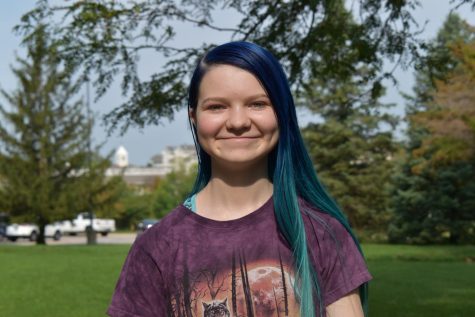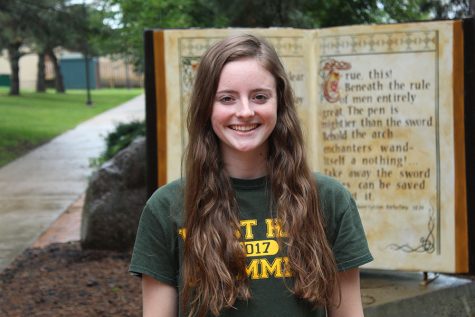Not seeing double
At first glance, identical twins may seem to be exactly the same, but in reality they are two separate people with separate identities.
Identical twins Lizzy Slade ‘21 and Makayla Slade ‘21 may look alike, but that is where most of the similarities end.
Lizzy wakes up at 7:00 a.m. every morning to get ready for school. She gets dressed, puts on makeup and goes to eat breakfast. After a foot reconstruction surgery on Feb. 6 for her dislocated toe, Lizzy has used crutches and has a boot, so getting ready takes longer than normal. At 7:30 a.m. she wakes up her sister for the first time before going to brush her teeth. Realizing that Makayla didn’t actually wake up, Lizzy tries again 15 minutes later, and then a final time five more minutes later.
Makayla, on the other hand, snoozes her alarms over and over again, getting up only ten minutes before they leave for school. She quickly gets dressed and leaves for school around 8:00 a.m. without eating breakfast.
While Lizzy and Makayla take the same courses except for AP Euro and World History, they don’t share any of the same teachers. Clueless that Lizzy and Makayla are twins, their teachers have on several occasions talked to the wrong one in the hallways.
“I’ve had a lot of Lizzy’s teachers come up to me saying, ‘Hey, you got out of your cast or your boot,’” Makayla said. “[I reply with], ‘I’m a twin, that’s not me. That’s Lizzy.’ And they’re like, ‘Oh my god, you have a twin. You guys look so much alike.’ Then they’ll go talk to Lizzy about it saying, ‘Oh, you never told me you had a twin. I feel so bad now.’”
“Obviously, it’s important to let people know I have a twin,” Lizzy continued, explaining that being a twin is often not a topic of discussion. “That’s not something you talk about [on a daily basis].”
Another pair of identical twins at West, Beyza Ilerisoy ‘20 and Fatma Ilerisoy ‘20, are also often mixed up.
“A lot of our teachers still mix us [up], but our friends are more used to us and are less likely to [be confused,]” Fatma said. “Personally, I find it funny and actually enjoy when people mix us up.”
Constantly getting switched around is just one effect of having an identical twin; Beyza and Fatma believe that the reason they are shy directly relates to being a twin.
“We don’t socialize a lot due to being together all the time,” Beyza said.
“It can change from twin to twin but if I didn’t have a twin I would have been a bit more social,” Fatma adds.
For Lizzy and Makayla, it is the exact opposite. Being twins has made them more outgoing, so they participate in sports to work with a group. Lizzy twirls for Ambition Baton Twirling and participates in pageants like Miss Iowa’s Outstanding Teen. Makayla plays with Iowa Soccer Club (ISC) and West High girls soccer.
“I love being a part of a group and working with other people,” Makayla said, “[That] is part of the reason I play soccer: because I get to work with teammates.”
“I think it’s because we’ve always had somebody there, so when we’re in a big group it’s very comforting for us,” Lizzy continued.
Sports is one of the only places where both Lizzy and Makayla believe that they are similar, even though they play different ones.
“Our personalities are similar if it’s about serious topics,” Makayla started. “We’re both very serious about-”
“-our sports and stuff,” Lizzy finished.
Lizzy and Makayla have a habit of finishing each other sentences, one of the only twin “myths” that is actually true.
“Most of the rumors about twins are wrong,” Beyza said. “However, we can complete each other’s sentences.”
Another common myth is that identical twins share personalities along with their DNA. This is not true. Most twins share some personality traits because they are often raised the same way and share many experiences, but they are not exactly alike. Beyza and Fatma believe that they have more similarities than differences, but they still are not the same.
“Personality-wise we are very different but our lifestyle is very similar,” Fatma said. “Both of us are shy and not very talkative, but my sister is more brave than I am and handles difficulties [in a calmer] way. I would [just] panic and wouldn’t know what to do.”
Lizzy and Makayla, however, think they have more differences than similarities. While they do recognize that part of it is due to constantly being compared, they still are unique. For instance, Lizzy tries to be more responsible and is more upbeat while Makayla goes with the flow.
“Whatever goes, goes as long as it’s not bad,” Makayla said. “I’m a lot more calm. She’s a lot more energetic.”
Their different personalities also show up in their appearances. Makayla wears a lot more athletic clothing while Lizzy wears trendy clothing.
“Lizzy wears her hair down and does makeup and stuff like that,” Makayla explained. “I wake up and throw on whatever clothes I can find and pull my hair up in a bun or a ponytail.”
This difference in clothing helps others tell them apart. Without this, they would look identical.
However, their birth certificates do not recognize that they are identical, and instead declares them fraternal. Fraternal twins occur when two separate eggs fertilized, while identical twins occur when there is one egg that splits into two during early development.
Identical twins share the exact same DNA, womb environment and many of the same experiences, making them look as identical as possible. Fraternal twins, since they came from two different eggs, share the same amount of DNA as if they were just siblings along with the womb environment and experiences.
When Lizzy and Makayla were born, they had two separate placentas and two separate amniotic sacs. This tends not to happen with identical twins because the placenta and the amniotic sac start to form after the first 48 hours and identical twins can split anywhere from the first few hours to nine full days. All fraternal twins, on the other hand, cannot share an amniotic sac because they come from two separate eggs.
The dilemma of whether or not they are identical can be solved with a simple DNA swab from the inside of their cheek. However, the implications that could come with that are anything but simple.
“For me, I’m identical,” Lizzy said. “I don’t want to have to start saying ‘Oh, I’m fraternal.’ So even though … it won’t change anything in our relationship or anything like that, I personally don’t want to [be tested] just because I’ve always been identical.”
Makayla, however, doesn’t think anything would change if they were fraternal. “I am down to [be tested]. It wouldn’t change anything for me,” she said.
This is just one of many small disagreements that the two share. Because Lizzy and Makayla spend most of their time together (the longest time they have spent apart is about a week) they often argue about small topics. These arguments stay civil and friendly, akin to banter.
“If it’s stupid little things we’ll just argue with each other for the fun of it,” Makayla said. “If we have nothing to do, [then] we’ll purposely annoy each other.”
Since they are in such close proximity to each other, this also means that they know the each other very well.
“We don’t really have to explain things [to each other] because we automatically understand what’s going on,” Makayla said. “Even if we have no idea, we’ll always just be there for the other one. Even if we don’t want them there, they’ll be there.”
Your donation will support the student journalists of West High School. Your contribution will allow us to purchase Scholarship Yearbooks, newsroom equipment and cover our annual website hosting costs.

(she/her) Bess Frerichs is the online managing and feature editor. As a senior, this is her third and final year on staff. She enjoys reading, writing...

Jessica is a senior at West High and is enjoying her third year on staff. Though not a baller, she truly excels when it comes to taking the mic at karaoke...


